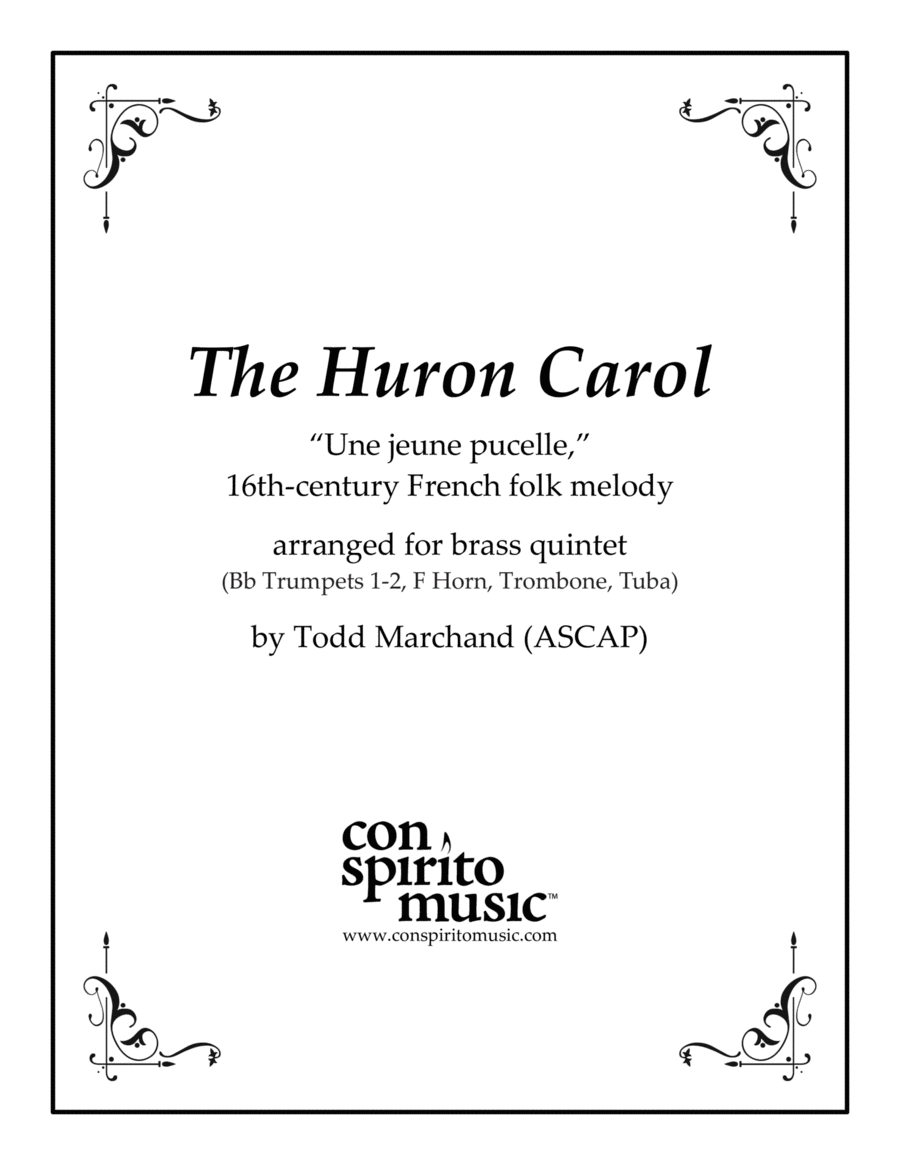Brass Ensemble,Brass Quintet Horn,Trombone,Trumpet,Tuba - Level 3 - Digital Download SKU: A0.1147711 Composed by Traditional French Melody. Arranged by Todd Marchand. Christian,Christmas,Holiday,Sacred,Traditional. Score and parts. 16 pages. Con Spirito Music #747929. Published by Con Spirito Music (A0.1147711). ‚ÄúThe Huron Carol‚ÄĚ is the popular name for a Christmas song written in the language of the Wendat, an indigenous people of Canada ‚ÄĒ their name meaning ‚Äúpeople of the island‚ÄĚ or ‚Äúdwellers on a peninsula‚ÄĚ ‚ÄĒ nicknamed ‚ÄúHuron‚ÄĚ (‚Äúboar's head‚ÄĚ) by French explorers and traders due to the bristly hairstyle of Wendat men.The song began as a tool for teaching and converting the Wendat to Christianity, and it was likely written in the early 1640s by the French Jesuit missionary, Jean de Br√©beuf. In Wendat, the song is titled ‚ÄúJesous Ahatonnia,‚ÄĚ which means ‚ÄúJesus is Born.‚ÄĚ The song's melody is based on a traditional French folk song, ‚ÄúUne Jeune Pucelle‚ÄĚ (‚ÄúA Young Maid‚ÄĚ). Jean de Br√©beuf‚Äôs lyrics present the Nativity story using images and ideas that would have been familiar to the Wendat. Angels are ‚Äúspirits‚ÄĚ and ‚Äúsky people‚ÄĚ; the Magi (wise men) are ‚Äúelders,‚ÄĚ and as an act of reverence they oil Jesus‚Äô scalp, a practice Wendat people would have recognized. Today, ‚ÄúThe Huron Carol's‚ÄĚ most well-known lyrics, beginning ‚Äú'Twas in the moon of winter-time,‚ÄĚ were written by Canadian poet Jesse Middleton and published in 1927 in a small illustrated book titled ‚ÄúThe First Canadian Christmas Carol.‚ÄĚMiddleton‚Äôs text is not a translation, but a complete rewriting of ‚ÄúJesous Ahatonnia‚ÄĚ for English speakers, and bears almost no relation to the original Wendat text. Middleton relied on stereotypes, critics say, painting a picture of an indigenous Nativity in a ‚Äúlodge of broken bark,‚ÄĚ with ‚Äúhunter braves‚ÄĚ replacing shepherds, and ‚Äúgifts of fur and beaver pelt‚ÄĚ delivered by ‚Äúchiefs from far.‚ÄĚ Still, the carol has long been popular, perhaps in part due to its refrain, ‚ÄúJesus your King is born, Jesus is born. In excelsis gloria!‚ÄĚ and its pairing with the easily singable ‚ÄúUne Jeune Pucelle‚ÄĚ tune.This arrangement for brass quintet takes a contemplative, lyrical approach, featuring rich harmonies to the chant-like tune and contrasts in dynamics and tempo that evoke both the quiet peace and solemnity accompanying the birth of Christ.¬©Copyright 2022 Todd Marchand / Con Spirito Music (ASCAP). All rights reserved. Visit www.conspiritomusic.com
